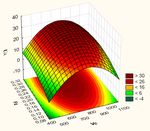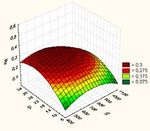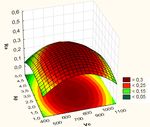Cutting data effect on machine tool vibrational state and surface roughness when machining
←
→
Page content transcription
If your browser does not render page correctly, please read the page content below
IOP Conference Series: Materials Science and Engineering
PAPER • OPEN ACCESS
Cutting data effect on machine tool vibrational state and surface
roughness when machining
To cite this article: Dmitry Aleynikov et al 2020 IOP Conf. Ser.: Mater. Sci. Eng. 709 022080
View the article online for updates and enhancements.
This content was downloaded from IP address 176.9.8.24 on 10/03/2020 at 14:32ICMTMTE IOP Publishing
IOP Conf. Series: Materials Science and Engineering 709 (2020) 022080 doi:10.1088/1757-899X/709/2/022080
Cutting data effect on machine tool vibrational state and
surface roughness when machining
Dmitry Aleynikov1, Anatoly Lukyanov2 and Andrey Savilov1,*
1
Irkutsk National Research Technical University, 664074, Irkutsk, Russia
2
Irkutsk State University of Railway Transport, 664074, Irkutsk, Russia
*saw@istu.edu
Abstract. The article is devoted to the study of vibration processes of metal-removal
equipment. In the course of the study, the dynamic phenomena arising in the metal processing
in this complex dynamic system have been investigated for the purpose of further control of
cutting modes that minimize the accompanying oscillations and vibrations. This article
presents the results of studying the dependence of the roughness parameters on the vibration of
the spindle assembly and processing modes in the milling operation. Planning techniques and
experimental statistic were used in our investigation. The dependence of vibration acceleration
root-mean square parameters (RMS parameters) on cutting set modes was determined.
Monitoring of vibration parameters when machining centres operating allows improving the
quality of parts processing and preventing expensive machine operating under dangerous
dynamic load.
1. Introduction
The elastic system of the machine tool is characterized by static rigidity - the tendency to move the
tool relative to the workpiece under the component P action of cutting force, and dynamic admittance
– the tendency to move because of disturbing periodic force-induced oscillations [2, 3]. The latter
characteristic reflects an important property is that the deformation in the machine tool depends not
only on the of applied forces magnitude in the processing, but also on the parameters of its
oscillations. Significant and dangerous resonant vibrations occur when the frequencies of these
vibrations coincide with the natural frequency of the machine and its components [1].
Accuracy decreases and the bearings service life and the machine tool a whole is reduces, the
roughness of processing is increased [4]. Meeting tolerance of processed surfaces roughness is one of
the main criteria of their quality. Roughness impacts such product performance properties as a life
time, fatigue strength and corrosion resistance of mating parts. The influence of cutting mode on the
surface roughness is studied well enough for metal alloys [5]. Nevertheless, the pattern of roughness
changes depending on vibration and processing modes is studied less. Some individual experimental
studies of vibration and roughness under different processing modes have shown that cutting speed
(V c ) and feed per tooth (F z ) have a significant impact on the response functions. This is most critical
in high-speed and high-productivity milling of aluminum alloys, as the cutting process is performed at
high spindle speeds with high dynamic loads [6-8]. Therefore, the risk of the above-mentioned
resonant vibrations increases [9,10]. The use of expensive machining centers and modern cutting tools
in these operations does not solve the problem.
Content from this work may be used under the terms of the Creative Commons Attribution 3.0 licence. Any further distribution
of this work must maintain attribution to the author(s) and the title of the work, journal citation and DOI.
Published under licence by IOP Publishing Ltd 1ICMTMTE IOP Publishing
IOP Conf. Series: Materials Science and Engineering 709 (2020) 022080 doi:10.1088/1757-899X/709/2/022080
In turn, correctly prescribed processing parameters, providing a stable cutting, allow to reach the
maximum process efficiency and to obtain significant economic benefit.
A number of researches are devoted to a study of the vibration generating mechanism during
cutting, in particular when milling [11,12]. But they tend to focus on the cutting process and pay
insufficient attention to the machine conditions and high vibrations impact evaluation for the condition
of equipment.
We carried out the experiments to study these processes and determine the mutual influence of
DMG DMC 635V machining center vibration state and the cutting modes with the machined surface
roughness parameters.
2. Materials and Methods
In the experimental part of the work the influence of processing modes on the machine vibration state
and machined surface roughness were exanimated. In our experiment we used the planning procedure.
The study was conducted according to the fractional four-factor three-level Box-Behnken design
[13,14]. Parameters that largely affect the roughness and dynamic behaviour of the machine tool were
determined as the studied factors: cutting speed, feed, width and depth of milling.
The experiment included the following stages: factor cording, design of experiment matrix,
experiment realization, repeatability checking, determination of regression coefficients significance
and model verification. Processing of the wrought aluminium alloy B95 billet was made by Sandvik
Coromant R790-032HA06S2-16M cutter with cutting head diameter D c =32 mm.
Passing milling was performed, because in this case the most favourable cutting process and
smaller possible displacements of the workpiece take place. Cutting modes, which are presented in
table 1, were specified on the recommendations of a tool manufacturer.
The lower and upper levels of rotation frequency correspond to non-resonant sections of amplitude-
frequency characteristics (AFC) of the DMC 635V machine tool, and the basic level is in the
resonance zone at a frequency of 125 Hz (Fig. 1).
Measurement of the machined surface roughness was performed with a profilometer Taylor
Hobson Form Talysurf i200.
Table 1. Cutting modes during the experiment.
Level’s value
Factor Code upper basic lower
V c , m/min x1 1000 750 500
f z , mm x2 0.3 0.2 0.1
a e , mm x3 12.8 8 3.2
a p , mm x4 4.5 3 1.5
On the basis of experimental design theory (using the software package Statistica 6.0) roughness
and vibration state models depending on the processing modes were obtained.
Registration of spatial vibration components was carried out by sensors AR85 using a multi-
channel signal converter National Instruments.
2ICMTMTE IOP Publishing
IOP Conf. Series: Materials Science and Engineering 709 (2020) 022080 doi:10.1088/1757-899X/709/2/022080
Figure 1. Levels of processing modes on the AFC chart
The evaluation of the vibration parameters during milling is performed by the averaged vector of
the root-mean-square (RMS) values of the vibration acceleration (m/s2) in three mutually
perpendicular directions of vibrations of a spindle assembly:
U A = СКЗ 2 2
X + СКЗ Y + СКЗ Z
2 (1)
The RMS parameter of vibration acceleration was selected from the time-history after the transition
process plot caused by the tool penetration. To exclude the influence of resonance properties of
magnetic clamping of the chopper, the initial vibration acceleration signal was filtered by using a
digital bandpass filter at a transmission frequency from 10 to 3500 Hz.
3. Results and Discussion
After performing all the necessary substitutions and transformations we obtain the RMS vibration
acceleration parameter−milling process studied factors equation (2):
U A = e − 188.562 Vc 57.702 − 4.376ln(Vc ) Fz − 0.533ln(Fz ) − 0.486 ⋅ (2)
⋅ А e 0.438 − 0.495ln(Fz ) − 0.313ln(А e ) А p1.84 − 0.659ln(А p ) ;
The response surfaces of the vibration acceleration RMS parameter depending on processing
modes are shown in figures 2, 3, respectively.
а) b)
Figure 2. Dependence of the RMS parameter on vibration acceleration Ua:
a – on the cutting speed Vc and feed to the tooth fz;
b – on cutting speed Vc and cutting depth of ap
3ICMTMTE IOP Publishing
IOP Conf. Series: Materials Science and Engineering 709 (2020) 022080 doi:10.1088/1757-899X/709/2/022080
а) b)
Figure 3. Dependence of the RMS parameter on vibration acceleration Ua:
a – on the cutting speed Vc and the cutting width ae;
b – on the cutting width Ae and the cutting depth ap
The quality of the machined surface finish was evaluated by the roughness parameter Ra of the
machined end surface. Dependence of surface roughness on the milling process factors (3):
R a = e − 117.096 Vc 34.831 − 2.657 ln(Vc ) Fz − 0.859 А p 0.896 + 0.512 ln(Fz ) ⋅
(3)
⋅ А e 2.632 − 0.715 ln(А e ) + 0.893 ln(Fz ) ;
The roughness parameter response surfaces of the processed surface depending on the machining
modes are presented in figures 4, 5 respectively.
а) b)
Figure 4. Dependences of the roughness parameter Ra:
a - on the cutting speed Vc and feed per tooth Fz;
b - cutting speed Vc and cutting depth ap
The response function of the roughness Ra depending on the cutting parameters (Vc, Fz) and
vibration has the following form (4):
2 2
Ra = 0,00016 ⋅ Vc − 0,2579 ⋅ Vc + 340,7249 ⋅ Fz − 177,9548 ⋅ Fz + Ua + 93,0396 ; (4)
а) b)
Figure 5. The mutual influence of machining parameters, surface roughness and vibration:
a – on cutting speed Vc and vibration Ua;
b – on feed per tooth Fz and vibration Ua
4ICMTMTE IOP Publishing
IOP Conf. Series: Materials Science and Engineering 709 (2020) 022080 doi:10.1088/1757-899X/709/2/022080
4. Conclusions
The analysis of the experimental results allows us to conclude that the dependence of processing center
vibration state on the processing modes is nonlinear, thereby confirming the presence of stable cutting zones and
effectiveness of high-speed processing methods.
The resonance areas that have been identified in the analysis of the amplitude-frequency characteristics
(AFC) significantly affect the milling process and lead to increasing in vibration parameters and enhancing the
machined surface roughness. Thus, the problem of cutting mode optimization according by processing criterion
in non-resonant areas of AFC becomes feasible when monitoring facilities and the vibration state diagnostic of
machine spindles are used.
The analysis of predictability self-oscillation excitation during milling on the basis of available information
regarding the machine tool parameters, the cutting tool, clamping equipment and the properties of the processed
material can be considered as the subject of further research.
Also an important factor is an objective evaluation of the vibrations impact on the equipment and their
impact on its operability and service life. In this case, the number of controlled parameters during machining
increases. In particular, cutting force is required to be measured. Meanwhile it should be taken into account not
only the specific value of the cutting forces projections at a given time, but also the laws of their changes.
References
[1] E. Budak and Y. Altintas, Journal of Dynamic Systems, Measurement, and Control,120,
10.1115/1.2801317 (1998)
[2] U. Karaguzela, M. Bakkal, E. Budak, Procedia CIRP 58 287–292 (2017)
[3] Campomanes ML, Altintas Y., Journal of Manufacturing Science and Engineering, 125 (3) 416-
422 (2003)
[4] Mark A. Rubeo and Tony L. Schmitz, Procedia Manufacturing, 5 90–105 (2016)
[5] Min Wan, Wei-Hong Zhang, Jian-Wei Dang, Yun Yang, Applied Mathematical Mod-elling 34
823–836 (2010)
[6] Savilov A.V., Pyatykh A.S., Vibration effect on accuracy and quality of hole surface under
drilling, Vestnik of ISTU, 12 (2013)
[7] Sinopalnikov V.A., Grigorjev S.N., Reliability and diagnostics of technological systems, 343
(2005)
[8] Aleynikov D.P., Lukyanov A.V., Cutting forces modeling and vibration diagnostics of signs of
end mills defects, Systems. Methods.Tehnologii, 1 (33) 39-47 (2017)
[9] PetruhinV.V., Fundamentals of vibration diagnostics and measuring vibration, 176 (2010)
[10] Grigorjev S.N., Gurin V.D., Kozochkin M.P., Diagnosis of computer-aided manufacturing, 600
(2011)
[11] Klyuyev V.V., Non-destructive testing, 8. 789 (2005)
[12] Takashi Matsumura, Shoichi Tamura, Procedia CIRP 58 566-571 (2017)
[13] Spiridonov A.A., Planning of the experiment in the study of technological processes, 184 (1981)
[14] Chinesta F., Filice L., Micari F., Rizzuti S. and Umbrello D., International Journal of Material
Forming, 1 507-510 (2008)
5You can also read


























































